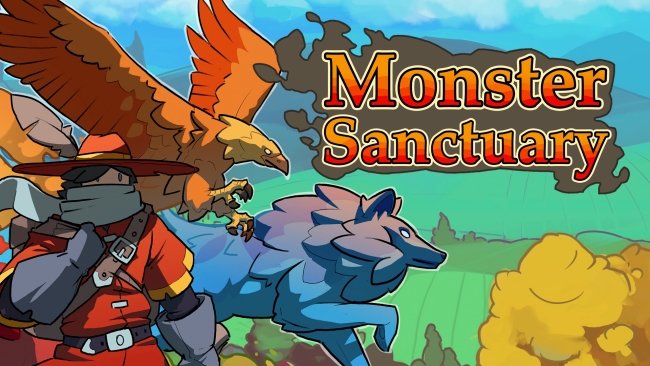Over the Christmas period there wasn’t a game I played more than Monster Sanctuary. Putting my festive annual leave to good use, there was no better way to spend it than sinking countless hours into a JRPG-inspired monster-collecting adventure. Monster Sanctuary is a mash-up of platforming, fetch quests and turn-based combat, and its 2D side-on perspective provides you with a MetroidVania-designed world to explore. At face value it may come across as a Poor-Man’s-Pokemon but don’t all monster-collecting games get assaulted with this allegation? Monster Sanctuary is more akin to Final Fantasy. The more time you spend with it the more you realise it’s not a Poor-Man’s-Pokemon at all, and in hindsight it reminded me more of a Monster Rancher game I once owned on PlayStation.
Monster Sanctuary takes place on Earth but during an alternate history where monster keepers have locked themselves away from the rest of mankind to preserve the existence of magic, monsters and our peaceful bond with them. A cult of alchemists, on the other hand, have been ostracised from society for their lust for monsters and magic, and they blame the monster keepers for keeping them hidden from the rest of the world. The alchemists hatch a plan to invade the Monster Sanctuary to use magic and monsters in their quest for world domination, so in retaliation you hatch an army of monsters and protect everything you hold dear!
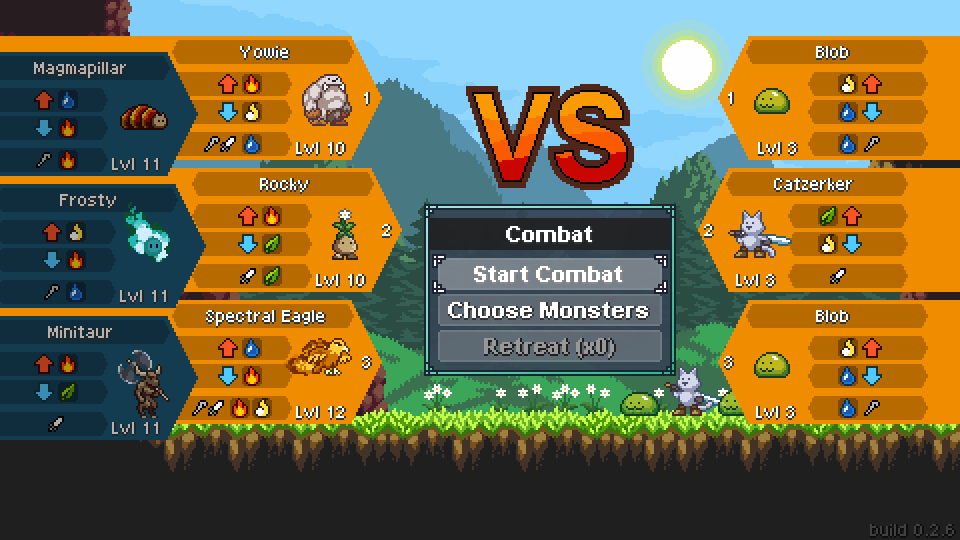
Unlike Pokemon, where you send one monster out at a time, Monster Sanctuary takes a feather out of Final Fantasy’s cap and has you assembling a party of three that fight as a team. When your monsters attack they stack up a combo meter, and this contributes to how much damage you inflict; basically, the higher the combo meter the stronger your last monster’s attack will be. Every attack has a different hit count, and passive moves like healing and buffing contribute to the combo meter, so there’s plenty of room to play about with strategy. Every monster belongs to an elemental class so expect the same rock-papers-scissors format you’re familiar with in Pokemon and Fire Emblem. You’re also encouraged to feed your monsters to increase their stats but I didn’t witness any improvement when I fed my monsters so it was the one mechanic I mostly ignored.
There are 100 monsters to collect but there isn’t much skill involved in collecting them because their eggs will be rewarded to you after combat encounters, alongside gold and crafting materials. The hardest monsters to get are the bosses because you need to finish them off quickly to be offered up an egg. I can’t say I was quick enough at killing bosses, so I was never able to hatch one of my own.
Monsters level up more traditionally too, with you investing skill points into a convoluted series of skill trees. Each move has its own skill tree, which in turn branch off to unlock buffs, elemental attacks, and general improvements to health, mana, attack and defence. You can also equip your monsters with up to three items that increase their stats. Although a some-what confusing idea I found it the most rewarding. You quickly notice how weak your ‘naked’ monsters are and I found it extremely beneficial to upgrade all of my monster’s equipment as often as possible.
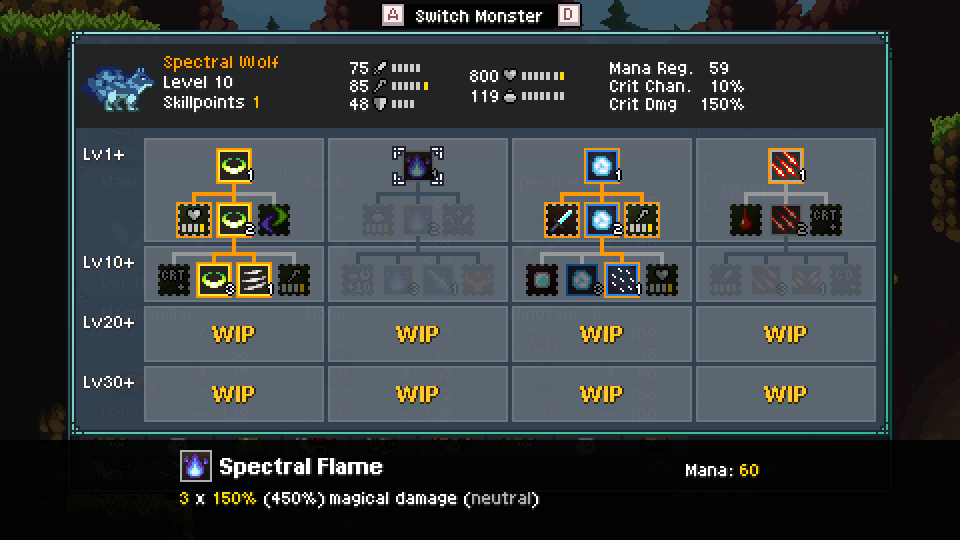
One of the coolest things about Monster Sanctuary is how you can select a monster to follow you around. Every monster has an ability too, so you’ll be swapping out which monster is on-screen depending on what skill you need. Some breathe fire, burning down vines. Others smash through brittle walls, revealing treasure. Need to see in the dark? Pick a monster with night vision! Need to get over a long gap? Get a bird or dragon to carry you across. One of Monster Sanctuary’s highlights was discovering shortcuts and new locales.
Speaking of locales, there’s a wide range of environments to visit. Each one has its own theme tune and the sound designer has done an amazing job creating songs that match the locations. The Sun Palace feels authentic because you can feel it bouncing off the metallic Asian-inspired architecture, and you can practically feel the sun on your skin and the sand beneath your toes on Horizon Beach.
Full disclosure though: I never finished Monster Sanctuary. Looking at a diagram of the full map, it’s obvious I must have only played about 75% of the game. In all honesty, I hit a brick wall that I wasn’t smart enough to get passed. Thinking back on my experience makes me genuinely sad because I was thoroughly enjoying it up until this point, and after a long time mulling it over in my head I think I know what happened: Monster Sanctuary stopped making sense to me.
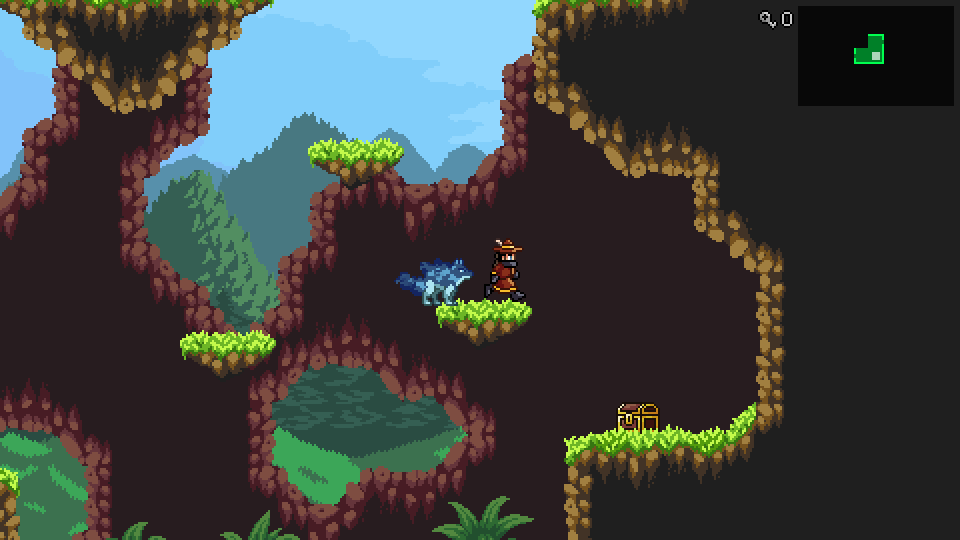
Let me explain: Every move uses mana and after every turn your monsters regenerate mana. Some monsters don’t have much mana but they have moves that require ALOT of mana. Clearly, there’s a disconnect here. I simply equipped my monster with something that boosted their mana. It was a simple solution but it never sat comfortably with me. I don’t remember any of this being explained. Sometimes moves would be greyed out so that I couldn’t use them, and then after my turn some random numbers would pop up above my monsters’ heads. It took me ages to realise mana was being used up and regenerating.
Monster Sanctuary also likes to give you loads of information. It’s so much in fact that I struggled to see how any of it was helpful. For example, if you hover over a move it’ll say something like “inflicts 205 damage + 50% of health (x2)”. What does that even mean? And why am I having to do mental gymnastics for every monster’s move list? Before encounters you’re able to tell what your enemies’ weaknesses and strengths are, yet on multiple occasions the info I was given didn’t seem to match the damage my elemental attacks should have been inflicting. Some monsters are vulnerable to non-elemental attacks and at no point does the game tell you that you need to go to a different menu that has an extra attack option on it.
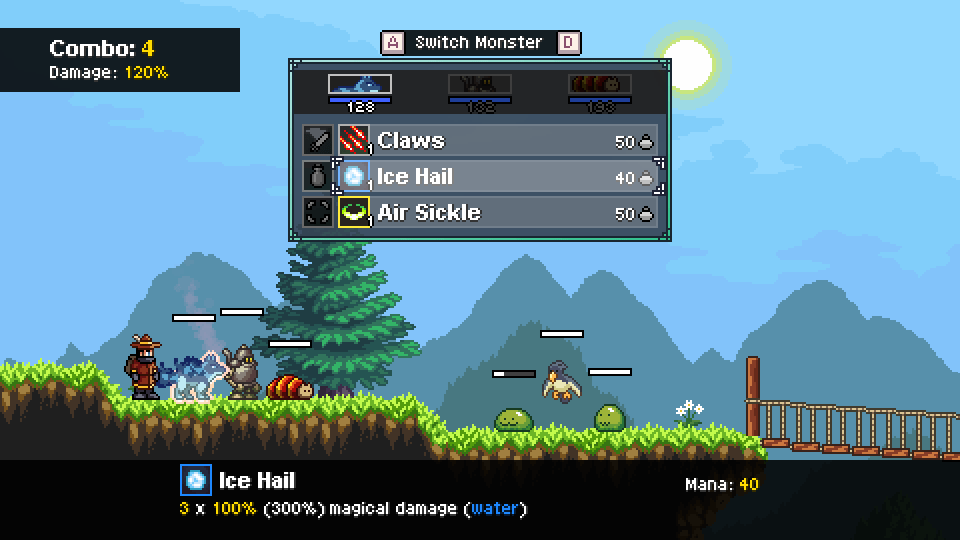
I have so many examples that are long-winded, boring, and darn right difficult to convey but to summarise: Monster Sanctuary is terrible at communicating. The reason I hit the unpassable brick wall was because I never understood how to play Monster Sanctuary correctly. When challenged, I was simply unprepared and (ironically) unequipped with the knowledge. Without going into spoilers, two new elemental types get introduced that drastically change how the game is played, and yet there’s not a single tutorial or explanation for how you’re supposed to use them to your advantage. I just found myself up against bosses that could completely re-heal their party, and I found myself banging my head on the brick wall until all my monsters were dead.
I have genuinely disliked writing this review because it has left me feeling deflated and agitated. I feel immature for blaming Monster Sanctuary for being a poor communicator but I can only tell you what I experienced. I had a lot of fun with it but I gave up because I felt cheated by it, and because of this I don’t think I can recommend it to anybody. I feel frustrated because Monster Sanctuary overloads you with data for you to take advantage of, and yet in the same breath it doesn’t do enough to educate you on how to use that data. Ultimately, because it’s over-complicated it renders itself pointless, and I worry that anyone else playing it might hit the same brick wall.
VERDICT
Should you play it? Maybe…
Why… When the game is basic and doesn’t expect much of you it’s a fun RPG. There’s something addictive about discovering new monsters and building your dream team. Discovering new locales is exciting too, which makes the world of Monster Sanctuary feel large, connected and tangible.
But… Eventually the game expects too much of you, and it does nothing to prepare you for the complexity it starts to force on you. Eventually, this is what pushed me to breaking point, resulting on me giving up entirely.
Reviewed on Switch.




